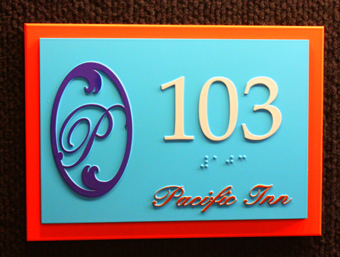 Sign manufacturers today have expanded options for crafting more appealing and effective signage through the U.S. Department of Justice’s Americans With Disabilities Act (ADA), which now permits a dual-signage option. A dual-sign contains signage elements for both the visually impaired and non-visually impaired.
Sign manufacturers today have expanded options for crafting more appealing and effective signage through the U.S. Department of Justice’s Americans With Disabilities Act (ADA), which now permits a dual-signage option. A dual-sign contains signage elements for both the visually impaired and non-visually impaired.
The 2010 ADA standards became mandatory March 15, and ADA’s dual-signage provisions have “definitely opened up the possibility for more creativity,” says Brad Harmon, president of Syntech Architectural Signage in Burlington, North Carolina.
Tina Kirk, general manager of ADA sales for Bell Company, Inc., in Trussville, Alabama, says, “A designer now has more freedom to choose any font or customized typography style for use on an ADA-compliant dual-message sign, as long as the sign also includes raised letters and Braille.”
Previous ADA guidelines clamped a lid on any creative typography for ADA signs, but today, sign shops have new opportunities to upsell consistent branding signage through the use of color and typography in a variety of venues. “Venues like [healthcare] and assisted-living facilities may now create a thematic visual theme deployed throughout the facility,” says Shelley Rosdahl, vice president of Sales for Star Signs, LLC, in Lawrence, Kansas, “instead of relying upon generic ADA signage purchased at a home improvement store.
“A sign maker may also construct Braille and raised characters with transparent materials or color-match characters to the sign’s background colors, so it doesn’t ‘pop up’ at you.”
Jon Wooldridge, vice president of SignMojo.com in Chattanooga, Tennessee, says that new signage is one of the least costly ways to have a big impact on the interior of a building. “You’d spend $25,000 painting the inside of a small nursing home yet only $5,000 redoing all the signs,” he says.
Harmony Martin, marketing manager for SignMojo.com in Chattanooga, Tennessee, says visual signs may now display serif fonts but not ones that are italic, oblique, or with an unusual form. “Still that’s a major step forward for companies that desire consistent branding throughout all the company’s signage,” she says.
Yet the new options do come with a learning curve.
“There’s [already] so much to learn in signage, and then you throw in all these subtle little regulations,” says Wooldridge. “What gets tactile lettering and what doesn’t? What’s a visual sign? What’s a permanent sign?
“I think if you polled the industry and people were really honest, you’d see a pretty high rate of confusion out there amongst a lot of the suppliers.”
Wooldridge points out that one of the things that tripped up a lot of people in the ADA business was the “70 percent contrast” between the visual characters and the background of the sign. “In the beginning, everybody thought, ‘Gee, all signs are now going to have to be black and white basically,’ but that’s not the case.
“The 70 percent contrast is a recommendation—not a mandate.”
 There are more choices available for installing ADA interior door signage too, says Wooldridge.
There are more choices available for installing ADA interior door signage too, says Wooldridge.
Under the 1990 ADA regulations, signs had to be wall-mounted on the left side of the door, sixty inches to center from the center of the sign to the base of the floor. Yet issues with compliance arose, particularly when sign installers had to accommodate existing architectural features (like sconces or molding). “If you couldn’t mount it, then what would you do?” says Wooldridge.
ADA signage professionals now have the option to install door signage directly onto the door—if the door has a compliant automatic closing device, doesn’t have a hold-open device, and the sign is placed on the push side. The door placement specifications also allow for a foot of wiggle room. “We spent the last ten years taking all signs off of hotel doors and putting them on the wall,” says Wooldridge, “and now, [this option] completely changes that back around.”
The updated ADA regulations provide a safe harbor provision for both sign manufacturers and their clients, if the sign’s owner is already compliant with 1990 ADA standards. “But if a facility undergoes a change in identity, as a result of a conversion, safe harbors for existing signage may be lost. “When they do a conversion or acquisition, they have to design the signs within the new parameters,” says Wooldridge.
As a general rule, ADA regulations are enforced via lawsuits (not regulators), with the U.S. Department of Justice as the arbiter. Since the ADA was defined in part through the outcome of lawsuits in the courts, Wooldridge says that it can be pretty ambiguous. “Advocacy groups may focus a spotlight on certain facilities and businesses to ensure those places are compliant,” he states.
“Even though ADA 2010 regulations are less restrictive when it comes to signage, some clients still insist on putting visual design ahead of regulations,” says Kirk. If educating the client as to what the law requires doesn’t work, her company will make the sign only after the client signs a disclaimer that the sign isn’t ADA-compliant.
There’s another wrinkle in the issue of compliance, according to Wooldridge, as companies that don’t have outside visitors may assume installing ADA signage inside the workplace isn’t necessary. “The ADA, first and foremost, is an employment act,” he says. “The regulations were also intended to protect internal employees.”
Harmon says although the new regulations bring expanded opportunities, they also carry risks for signage contractors, since some local code enforcement officers haven’t yet caught up with the change. “We’ve already seen vastly different rulings from one jurisdiction to the next on what is not compliant,” he says, noting that these officials may go well beyond what ADA regulations require. “On a local project, the code enforcement officer wanted tactile signage put inside the bedrooms of private apartments. It becomes completely subjective. It’s what they interpret it to be.”
Harmon advises sign makers to work collaboratively with the code enforcement officer heading up a particular project. This ensures that a sign maker isn’t surprised at the eleventh hour and has signs rejected for one reason or another.
Maureen Kalmykow, a sign consultant for AS&G Lettering Systems in Toronto, Ontario, cautions sign makers to pay very close attention to the regulations. “In this economy, everybody is selling on time and price,” she says. “I think that’s one of the big problems with this economy. But to make a compliant sign, you cannot cut corners.” (Note: Kalmykow also says the problem of non-compliance is more of an issue among independent sign shops.)
Even though Wooldridge says there are “guardrails built around what the manufacturers and designers can do,” the 2010 ADA standards still allow “for a lot of design-driven products.” And that’s welcome news for signage designers.
—Jan Fletcher
Top photo courtesy of Bell Company, Inc.











